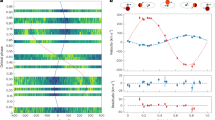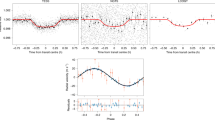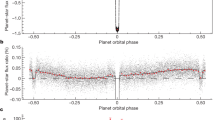Abstract
The amount of ultraviolet irradiation and ablation experienced by a planet depends strongly on the temperature of its host star. Of the thousands of extrasolar planets now known, only six have been found that transit hot, A-type stars (with temperatures of 7,300–10,000 kelvin), and no planets are known to transit the even hotter B-type stars. For example, WASP-33 is an A-type star with a temperature of about 7,430 kelvin, which hosts the hottest known transiting planet, WASP-33b (ref. 1); the planet is itself as hot as a red dwarf star of type M (ref. 2). WASP-33b displays a large heat differential between its dayside and nightside2, and is highly inflated–traits that have been linked to high insolation3,4. However, even at the temperature of its dayside, its atmosphere probably resembles the molecule-dominated atmospheres of other planets and, given the level of ultraviolet irradiation it experiences, its atmosphere is unlikely to be substantially ablated over the lifetime of its star. Here we report observations of the bright star HD 195689 (also known as KELT-9), which reveal a close-in (orbital period of about 1.48 days) transiting giant planet, KELT-9b. At approximately 10,170 kelvin, the host star is at the dividing line between stars of type A and B, and we measure the dayside temperature of KELT-9b to be about 4,600 kelvin. This is as hot as stars of stellar type K4 (ref. 5). The molecules in K stars are entirely dissociated, and so the primary sources of opacity in the dayside atmosphere of KELT-9b are probably atomic metals. Furthermore, KELT-9b receives 700 times more extreme-ultraviolet radiation (that is, with wavelengths shorter than 91.2 nanometres) than WASP-33b, leading to a predicted range of mass-loss rates that could leave the planet largely stripped of its envelope during the main-sequence lifetime of the host star6.
This is a preview of subscription content, access via your institution
Access options
Access Nature and 54 other Nature Portfolio journals
Get Nature+, our best-value online-access subscription
$29.99 / 30 days
cancel any time
Subscribe to this journal
Receive 51 print issues and online access
$199.00 per year
only $3.90 per issue
Buy this article
- Purchase on Springer Link
- Instant access to full article PDF
Prices may be subject to local taxes which are calculated during checkout



Similar content being viewed by others
References
Collier Cameron, A. et al. Line-profile tomography of exoplanet transits – II. A gas-giant planet transiting a rapidly rotating A5 star. Mon. Not. R. Astron. Soc. 407, 507–514 (2010)
von Essen, C. et al. A temperature inversion in WASP-33b? Large Binocular Telescope occultation data confirm significant thermal flux at short wavelengths. Astron. Astrophys. 584, A75 (2015)
Komacek, T. D. & Showman, A. P. Atmospheric circulation of hot Jupiters: dayside-nightside temperature differences. Astrophys. J. 821, 16 (2016)
Demory, B.-O. & Seager, S. Lack of inflated radii for Kepler giant planet candidates receiving modest stellar irradiation. Astrophys. J. 197, 12 (2011)
Pecaut, M. J. & Mamajek, E. E. Intrinsic colors, temperatures, and bolometric corrections of pre-main-sequence stars. Astrophys. J. Suppl. Ser. 208, 9 (2013)
Murray-Clay, R. A., Chiang, E. I. & Murray, N. Atmospheric escape from hot Jupiters. Astrophys. J. 693, 23–42 (2009)
Charbonneau, D., Brown, T. M., Latham, D. W. & Mayor, M. Detection of planetary transits across a Sun-like star. Astrophys. J. 529, L45–L48 (2000)
Henry, G. W., Marcy, G. W., Butler, R. P. & Vogt, S. S. A transiting “51 Peg-like” planet. Astrophys. J. 529, L41–L44 (2000)
Hartman, J. D. et al. HAT-P-57b: a short-period giant planet transiting a bright rapidly rotating A8V star confirmed via Doppler tomography. Astron. J. 150, 197 (2015)
Zhou, G. et al. HAT-P-67b: an extremely low density Saturn transiting an F-subgiant confirmed via Doppler tomography. Astron. J. 153, 211 (2017)
Borucki, W. J. et al. Kepler planet-detection mission: introduction and first results. Science 327, 977–980 (2010)
Johnson, J. A. et al. Retired A stars and their companions: exoplanets orbiting three intermediate-mass subgiants. Astrophys. J. 665, 785–793 (2007)
Lloyd, J. P. “Retired” planet hosts: not so massive, maybe just portly after lunch. Astrophys. J. 739, L49 (2011)
Schlaufman, K. C. & Winn, J. N. Evidence for the tidal destruction of hot Jupiters by subgiant stars. Astrophys. J. 772, 143 (2013)
Galland, F. et al. Extrasolar planets and brown dwarfs around A-F type stars. I. Performances of radial velocity measurements, first analyses of variations. Astron. Astrophys. 443, 337–345 (2005)
Borgniet, S., Lagrange, A.-M., Meunier, N. & Galland, F. Extrasolar planets and brown dwarfs around AF-type stars. IX. The HARPS southern sample. Astron. Astrophys. 599, A57 (2017)
Pepper, J. et al. The Kilodegree Extremely Little Telescope (KELT): a small robotic telescope for large-area synoptic surveys. Publ. Astron. Soc. Pacif. 119, 923–935 (2007)
Pepper, J., Kuhn, R. B., Siverd, R., James, D. & Stassun, K. The KELT-South telescope. Publ. Astron. Soc. Pacif. 124, 230–241 (2012)
Casewell, S. L. et al. Multiwaveband photometry of the irradiated brown dwarf WD0137–349B. Mon. Not. R. Astron. Soc. 447, 3218–3226 (2015)
Metzger, B. D., Giannios, D. & Spiegel, D. S. Optical and X-ray transients from planet-star mergers. Mon. Not. R. Astron. Soc. 425, 2778–2798 (2012)
Aguilera-Gómez, C., Chanamé, J., Pinsonneault, M. H. & Carlberg, J. K. On lithium-rich red giants. I. Engulfment of substellar companions. Astrophys. J. 829, 127 (2016)
Gillon, M. et al. Seven temperate terrestrial planets around the nearby ultracool dwarf star TRAPPIST-1. Nature 542, 456–460 (2017)
Eastman, J., Gaudi, B. S. & Agol, E. EXOFAST: a fast exoplanetary fitting suite in IDL. Publ. Astron. Soc. Pacif. 125, 83–112 (2013)
Demarque, P., Woo, J.-H., Kim, Y.-C. & Yi, S. K. Y2 isochrones with an improved core overshoot treatment. Astrophys. J. 155, 667–674 (2004)
Torres, G., Andersen, J. & Giménez, A. Accurate masses and radii of normal stars: modern results and applications. Astron. Astrophys. Rev. 18, 67–126 (2010)
van Leeuwen, F. Validation of the new Hipparcos reduction. Astron. Astrophys. 474, 653–664 (2007)
Gaia Collaboration. Gaia Data Release 1. Summary of the astrometric, photometric, and survey properties. Astron. Astrophys. 595, A2 (2016)
Stassun, K. G., Collins, K. A. & Gaudi, B. S. Accurate, empirical radii and masses of planets and their host stars with Gaia parallaxes. Astron. J. 153, 136–155 (2017)
Siverd, R. J. et al. KELT-1b: a strongly irradiated, highly inflated, short period, 27 Jupiter-mass companion transiting a mid-F star. Astrophys. J. 761, 123 (2012)
Johnson, M. C., Cochran, W. D., Collier Cameron, A. & Bayliss, D. Measurement of the nodal precession of WASP-33 b via Doppler tomography. Astrophys. J. 810, L23 (2015)
Collier Cameron, A. et al. Efficient identification of exoplanetary transit candidates from SuperWASP light curves. Mon. Not. R. Astron. Soc. 380, 1230–1244 (2007)
Donati, J.-F., Semel, M., Carter, B. D., Rees, D. E. & Collier Cameron, A. Spectropolarimetric observations of active stars. Mon. Not. R. Astron. Soc. 291, 658 (1997)
Zhou, G. et al. Spin-orbit alignment for KELT-7b and HAT-P-56b via Doppler tomography with TRES. Mon. Not. R. Astron. Soc. 460, 3376–3383 (2016)
Thompson, G. I. et al. Catalogue of stellar ultraviolet fluxes (TD1): A compilation of absolute stellar fluxes measured by the Sky Survey Telescope (S2/68) aboard the ESRO satellite TD-1. (VizieR Online Data Catalogue, number 2059, 2005); available at http://adsabs.harvard.edu/abs/1995yCat.2059....0T.
Mermilliod, J. C. Homogeneous means in the UBV system. (VizieR Online Data Catalog, number 2168, 2006); available at http://adsabs.harvard.edu/abs/2006yCat.2168....0M.
Høg, E. et al. The Tycho-2 catalogue of the 2.5 million brightest stars. Astron. Astrophys. 355, L27–L30 (2000)
Droege, T. F., Richmond, M. W., Sallman, M. P. & Creager, R. P. TASS Mark IV photometric survey of the northern sky. Publ. Astron. Soc. Pacif. 118, 1666–1678 (2006)
Cutri, R. M. et al. 2MASS All-Sky Catalog of Point Sources. (VizieR Online Data Catalog, number 2246, 2003); available at http://adsabs.harvard.edu/abs/2003yCat.2246....0C.
Skrutskie, M. F. et al. The Two Micron All Sky Survey (2MASS). Astron. J. 131, 1163–1183 (2006)
Wright, E. L. et al. The Wide-field Infrared Survey Explorer (WISE): mission description and initial on-orbit performance. Astron. J. 140, 1868–1881 (2010)
Cutri, R. M. et al. WISE All-Sky Data Release (2012). (VizieR Online Data Catalog, number 2311, 2012); available at http://adsabs.harvard.edu/abs/2012yCat.2311....0C.
Zacharias, N. et al. The Fourth US Naval Observatory CCD Astrograph Catalog (UCAC4). Astron. J. 145, 44 (2013)
Zacharias, N. et al. The Naval Observatory Merged Astrometric Dataset (NOMAD). Bull. Am. Astron. Soc. 36, 1418 (2004)
Kurucz, R. L. in The Stellar Populations of Galaxies (eds Barbuy, B. & Renzini, A. ) 225 (IAU Symp. 149, Kluwer Academic, 1992)
Schlegel, D. J., Finkbeiner, D. P. & Davis, M. Maps of dust infrared emission for use in estimation of reddening and cosmic microwave background radiation foregrounds. Astrophys. J. 500, 525–553 (1998)
Nelder, J. A. & Mead, R. A simplex method for function minimization. Comput. J. 7, 308–313 (1965)
Boué, G., Montalto, M., Boisse, I., Oshagh, M. & Santos, N. C. New analytical expressions of the Rossiter-McLaughlin effect adapted to different observation techniques. Astron. Astrophys. 550, A53 (2013)
Gray, D. F. The Observation and Analysis of Stellar Photospheres (Cambridge Univ. Press, 2008)
Collier Cameron, A., Bruce, V. A., Miller, G. R. M., Triaud, A. H. M. J. & Queloz, D. Line-profile tomography of exoplanet transits – I. The Doppler shadow of HD 189733b. Mon. Not. R. Astron. Soc. 403, 151–158 (2010)
Rossiter, R. A. On the detection of an effect of rotation during eclipse in the velocity of the brighter component of beta Lyrae, and on the constancy of velocity of this system. Astrophys. J. 60, 15–21 (1924)
McLaughlin, D. B. Some results of a spectrographic study of the Algol system. Astrophys. J. 60, 22–31 (1924)
Bieryla, A. et al. KELT-7b: A hot Jupiter transiting a bright V = 8.54 rapidly rotating F-star. Astron. J. 150, 12 (2015)
Lomb, N. R. Least-squares frequency analysis of unequally spaced data. Astrophys. Space Sci. 39, 447–462 (1976)
Scargle, J. D. Studies in astronomical time series analysis. II – Statistical aspects of spectral analysis of unevenly spaced data. Astrophys. J. 263, 835–853 (1982)
Kunitomo, M., Ikoma, M., Sato, B., Katsuta, Y. & Ida, S. Planet engulfment by ~1.5–3 M☉ red giants. Astrophys. J. 737, 66 (2011)
Privitera, G. et al. Star-planet interactions. II. Is planet engulfment the origin of fast rotating red giants? Astron. Astrophys. 593, A128 (2016)
Villaver, E. & Livio, M. Can planets survive stellar evolution? Astrophys. J. 661, 1192–1201 (2007)
Acknowledgements
This research was made possible by the KELT survey, the KELT Follow-Up Network, and support from The Ohio State University, Vanderbilt University and Lehigh University. Work by B.S.G. and D.J.S. was partially supported by NSF CAREER grant AST-1056524. K.G.S. and K.A.C. acknowledge partial support from NSF PAARE grant AST-1358862. B.S.G. acknowledges support by the Jet Propulsion Laboratory, operated by the California Institute of Technology, and the Exoplanet Exploration Program of the National Aeronautics and Space Administration (NASA). B.J.F. notes that this material is based upon work supported by the National Science Foundation Graduate Research Fellowship under grant no. 2014184874. Any opinion, findings, and conclusions or recommendations expressed in this material are those of the authors(s) and do not necessarily reflect the views of the National Science Foundation. Work performed by J.E.R. was supported by the Harvard Future Faculty Leaders Postdoctoral fellowship. K.K.M. acknowledges the purchase of SDSS filters for Whitin Observatory by the Theodore Dunham Jr Grant of the Fund for Astronomical Research. N.N. acknowledges support by the Japan Society for Promotion of Science (JSPS) KAKENHI Grant Number JP25247026. We acknowledge observations by M. Kunitomo, R. Hasegawa, B. Sato, H. Harakawa, T. Hirano and H. Izumiura on the Okayama 188 cm telescope (HIDES observations) and N. Kusakabe, M. Onitsuka and T. Ryu for MuSCAT observations. The NIRC2 AO data in this work were obtained at the W.M.Keck Observatory, which was financed by the W.M. Keck Foundation and is operated as a scientific partnership between the California Institute of Technology, the University of California and NASA. The authors wish to recognize and acknowledge the very significant cultural role and reverence that the summit of Mauna Kea has always had within the indigenous Hawaiian community. We are most fortunate to have the opportunity to conduct observations from this mountain. This work has made use of NASA’s Astrophysics Data System, the Exoplanets Data Explorer at exoplanets.org, the Extrasolar Planet Encyclopedia at exoplanet.eu, the SIMBAD database operated at CDS, Strasbourg, France, and the VizieR catalogue access tool, CDS, Strasbourg, France. This publication makes use of data products from the Widefield Infrared Survey Explorer, which is a joint project of the University of California, Los Angeles; the Jet Propulsion Laboratory/California Institute of Technology, which is funded by NASA; the Two Micron All Sky Survey, which is a joint project of the University of Massachusetts and the Infrared Processing and Analysis Center/California Institute of Technology, funded by NASA; and the American Association of Variable Star Observers (AAVSO) Photometric All-Sky Survey (APASS), whose funding is provided by the Robert Martin Ayers Sciences Fund and the AAVSO Endowment (https://www.aavso.org/aavso-photometric-all-sky-survey-data-release-1). We acknowledge input from T. Barman, J. Fortney, M. Marley and K. Zanhle.
Author information
Authors and Affiliations
Contributions
B.S.G. led the process from initial candidate selection to final planet confirmation. B.S.G. and K.G.S. wrote the majority of the main manuscript and contributed to the analysis of the results. K.A.C. principally coordinated the assemblage of the final results and production of the Methods. T.G.B. and G.Z. led the Doppler tomographic analysis, and also contributed to the final modelling and interpretation. J.D.E., R.J.S., D.J.S., L.A.B., J.P., J.E.R., K.D.C., M.C.J. and M.P. all provided critical insight, analysis or interpretation of the system. G.D., V.B., S.C.N., M.T.D., T.E., C.G., H.J.-C., D.H.K., A.F., J.G., A.I., J.F.K., M.M., K.M., N.N., T.E.O., P.A.R., G.S., D.C.S., R.R.Y., R.Z., B.J.F. and A.H. all provided photometric or radial velocity data that were important for the interpretation of the system. J.C. and E.J.G. provided the observations and analysis of the Keck AO data. E.L.N.J., D.J.J., D.B., I.A.C., D.L.D., G.A.E., A.G., M.D.J., R.B.K., J.L.-B., M.B.L., J.M., K.K.M., R.W.P., H.R., D.C.S., C.S., T.G.T., M.T. and P.T. have all been essential for the initiation and successful operation of the KELT-North and KELT-South surveys. All of the authors have read the manuscript and concur with the conclusions therein.
Corresponding author
Ethics declarations
Competing interests
The authors declare no competing financial interests.
Additional information
Reviewer Information Nature thanks D. Deming and the other anonymous reviewer(s) for their contribution to the peer review of this work.
Publisher's note: Springer Nature remains neutral with regard to jurisdictional claims in published maps and institutional affiliations.
Extended data figures and tables
Extended Data Figure 1 Doppler tomographic line profile plots.
Left, middle and right columns correspond to the three nights when KELT-9 was observed during transit. Top row, spectroscopic data (orbital phase); middle row, the derived model; bottom row, the residuals. In each panel, the vertical blue lines denote the width of the convolution kernel (that is, v sin I*), and the horizontal blue lines show the duration of the transit. Time increases vertically for each panel. The apparent extension of the Doppler shadow before ingress on ut 2014 October 05 is an artefact of uneven and widely spaced sampling in time. The greyscale shows the fractional variation in the spectroscopic signal from the null hypothesis of no shadow due to a transiting planet. Darker regions indicate the Doppler shadow as the planet crosses the face of the host star. Note the transit is nearly coincident with the projected stellar spin axis, implying a nearly polar orbit for the planet.
Extended Data Figure 2 KELT-9 spectral energy distribution.
Crosses represent the measured fluxes, with vertical error bars representing the uncertainties in the measurements as quantified by the standard deviation and the horizontal error bars representing the width of the bandpass. The blue dots are the predicted passband-integrated fluxes of the best-fit theoretical spectral energy distribution (SED) corresponding to our observed photometric bands. The black curve represents the best-fit Kurucz stellar atmosphere44. Here λ is the wavelength and Fλ the monochromatic flux (flux at wavelength λ).
Extended Data Figure 3 Evolution of the KELT-9 system in the Hertzsprung–Russell diagram.
The red cross represents the system parameters from the initial SED fit, the blue cross represents the final system parameters from the global fit. The black curve represents the theoretical evolutionary track for a star with the mass and metallicity of KELT-9, and the grey swath bounded by dashed lines represents the uncertainty (standard deviation) on that track based on the uncertainties in mass and metallicity. Nominal ages in billions of years are shown as blue dots. When KELT-9 evolves to the base of the giant branch in 200–300 Myr, it will encroach upon the orbit of KELT-9b. The fate of the system at that point is highly uncertain20,21,55,56,57. Here Teff is the stellar effective temperature and g* is the surface gravity.
Rights and permissions
About this article
Cite this article
Gaudi, B., Stassun, K., Collins, K. et al. A giant planet undergoing extreme-ultraviolet irradiation by its hot massive-star host. Nature 546, 514–518 (2017). https://doi.org/10.1038/nature22392
Received:
Accepted:
Published:
Issue Date:
DOI: https://doi.org/10.1038/nature22392
This article is cited by
-
An irradiated-Jupiter analogue hotter than the Sun
Nature Astronomy (2023)
-
Dynamics and clouds in planetary atmospheres from telescopic observations
The Astronomy and Astrophysics Review (2023)
-
Revealing the atmospheres of highly irradiated exoplanets: from ultra-hot Jupiters to rocky worlds
Astrophysics and Space Science (2023)
-
Oxygen as atmospheric thermometer
Nature Astronomy (2022)
-
Titanium oxide and chemical inhomogeneity in the atmosphere of the exoplanet WASP-189 b
Nature Astronomy (2022)
Comments
By submitting a comment you agree to abide by our Terms and Community Guidelines. If you find something abusive or that does not comply with our terms or guidelines please flag it as inappropriate.



